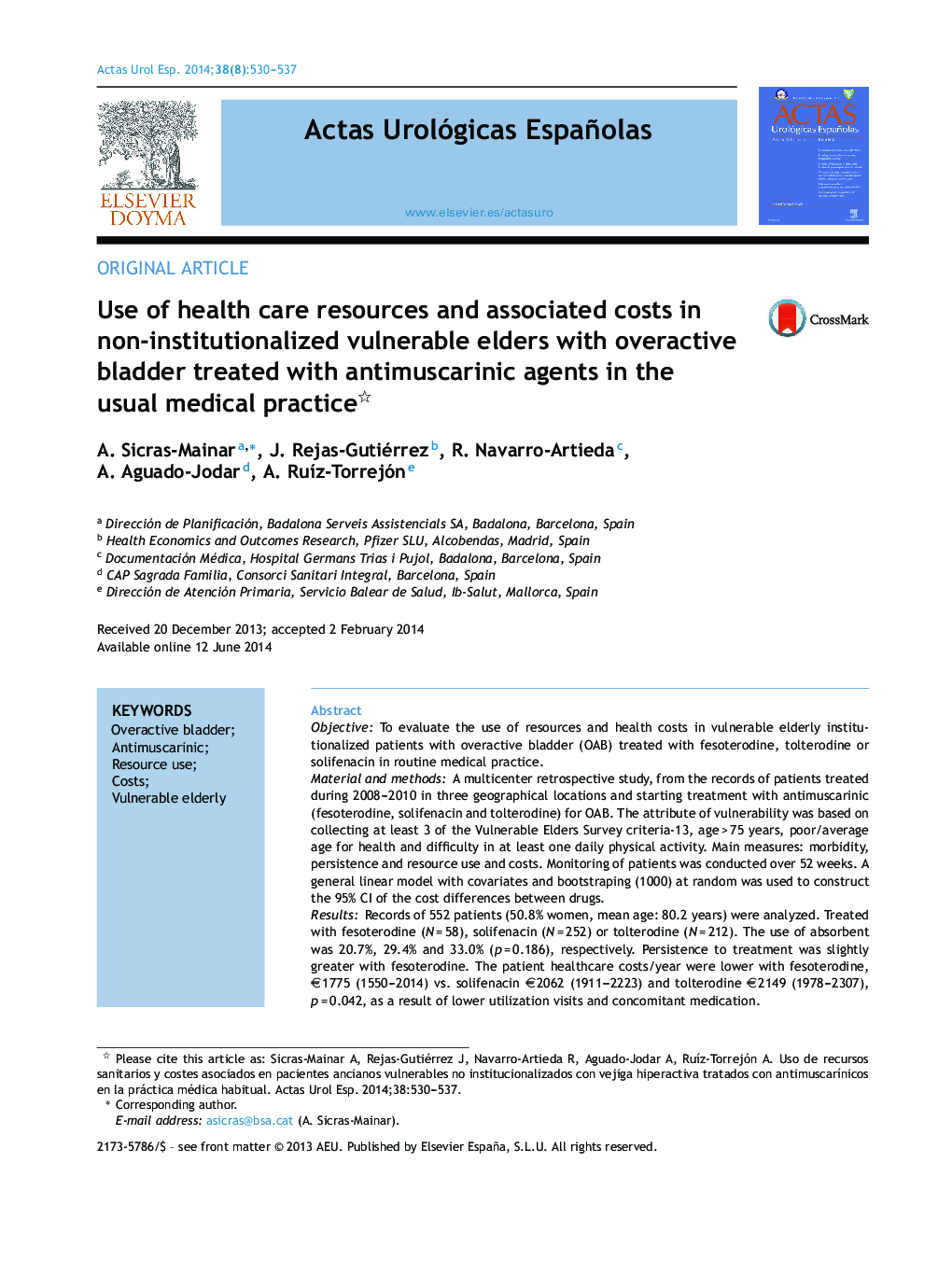| Article ID | Journal | Published Year | Pages | File Type |
|---|---|---|---|---|
| 3845397 | Actas Urológicas Españolas (English Edition) | 2014 | 8 Pages |
ObjectiveTo evaluate the use of resources and health costs in vulnerable elderly institutionalized patients with overactive bladder (OAB) treated with fesoterodine, tolterodine or solifenacin in routine medical practice.Material and methodsA multicenter retrospective study, from the records of patients treated during 2008–2010 in three geographical locations and starting treatment with antimuscarinic (fesoterodine, solifenacin and tolterodine) for OAB. The attribute of vulnerability was based on collecting at least 3 of the Vulnerable Elders Survey criteria-13, age > 75 years, poor/average age for health and difficulty in at least one daily physical activity. Main measures: morbidity, persistence and resource use and costs. Monitoring of patients was conducted over 52 weeks. A general linear model with covariates and bootstraping (1000) at random was used to construct the 95% CI of the cost differences between drugs.ResultsRecords of 552 patients (50.8% women, mean age: 80.2 years) were analyzed. Treated with fesoterodine (N = 58), solifenacin (N = 252) or tolterodine (N = 212). The use of absorbent was 20.7%, 29.4% and 33.0% (p = 0.186), respectively. Persistence to treatment was slightly greater with fesoterodine. The patient healthcare costs/year were lower with fesoterodine, €1775 (1550–2014) vs. solifenacin €2062 (1911–2223) and tolterodine €2149 (1978–2307), p = 0.042, as a result of lower utilization visits and concomitant medication.ConclusionsDespite the potential limitations of the study, the vulnerable elderly non institutionalized patients with OAB treated with fesoterodine, compared to solifenacin or tolterodine were associated with lower resource utilization and healthcare costs.
ResumenObjetivoEvaluar el uso de recursos y costes sanitarios en pacientes ancianos vulnerables no institucionalizados con vejiga hiperactiva (VH) tratados con fesoterodina, solifenacina o tolterodina en la práctica médica habitual.Material y métodosEstudio multicéntrico, retrospectivo, realizado a partir de los registros de pacientes atendidos durante 2008–2010 en 3 localidades geográficas y que iniciaron tratamiento con antimuscarínicos (fesoterodina, solifenacina y tolterodina) para la VH. El atributo de vulnerabilidad se basó en reunir, al menos, 3 de los criterios del Vulnerable-Elders Survey-13; edad > 75 años, salud pobre/normal para la edad y alguna dificultad en al menos una actividad física diaria. Principales medidas: comorbilidad, persistencia y uso de recursos y costes. El seguimiento de los pacientes se realizó durante 52 semanas. Se utilizó un modelo lineal general con covariables y remuestreo (1000) aleatorio para construir el IC 95% de las diferencias de costes entre fármacos.ResultadosSe analizaron registros de 552 pacientes (50,8% mujeres, edad media: 80,2 años), tratados con fesoterodina (n = 58), solifenacina (n = 252) o tolterodina (n = 212). El uso de absorbentes fue del 20,7, 29,4 y 33,0% (p = 0,186), respectivamente. La persistencia al tratamiento fue ligeramente mayor con fesoterodina. Los costes sanitarios paciente/año fueron inferiores con fesoterodina, 1775€ (1550–2014) vs. solifenacina 2062€ (1911–2223) y tolterodina 2149€ (1978–2307), p = 0,042, como consecuencia de una menor utilización de visitas y medicación concomitante.ConclusionesA pesar de las posibles limitaciones del estudio, los pacientes ancianos vulnerables no institucionalizados con VH tratados con fesoterodina, en comparación con solifenacina o tolterodina, se asociaron a una menor utilización de recursos y costes sanitarios.
